
- News
- Basics
- Products
- JP Job shop
- Exhibition
- Interview
- Statistic
- PR
- Download
- Special contents
Basics
March 30, 2022
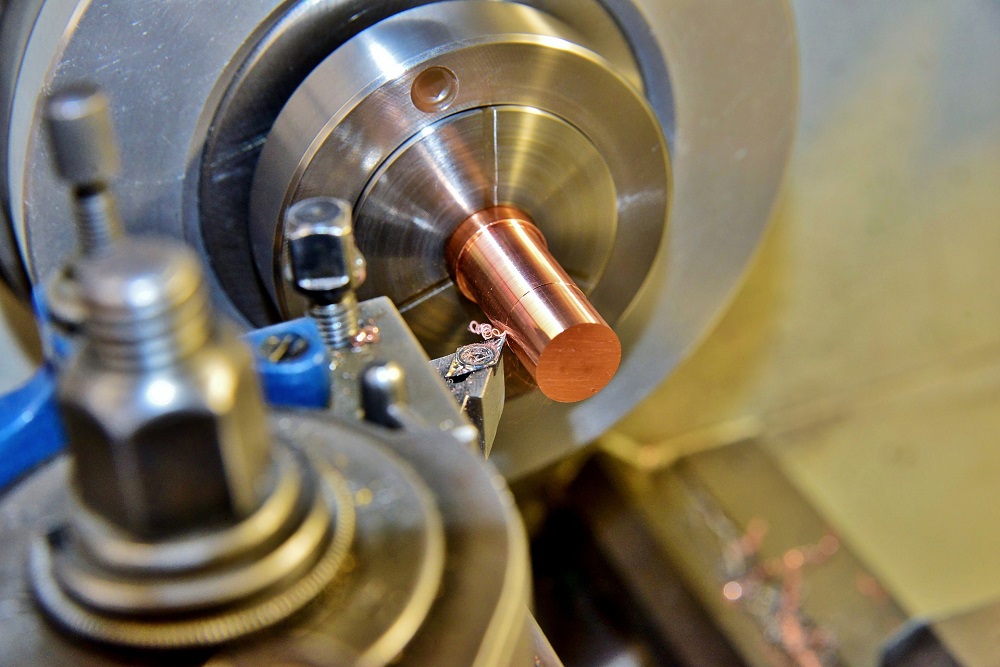
Contents:
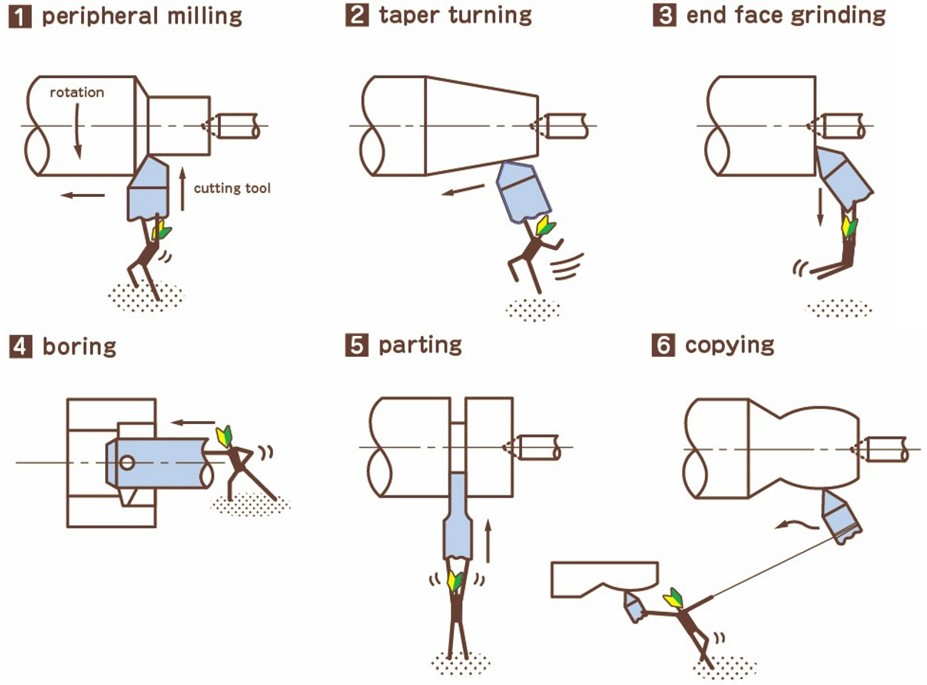
Various types of turning
Key Points of Lathe
・ Turning is the process by pressing a tool bit against a rotating workpiece to remove material.
・ NC lathe equipped with the numerical control device is major for turning, comparing with general purpose lathe.
・ Lathe size is represented a size of swing and distance between centers.
A lathe is a machine tool that processes metal by pressing a cutting tool, called a tool bit, onto the rotating material to cut it into a cylindrical shape. Lathes produce various cylindrical parts, including shafts and pins. Turning is the machining of a rotating workpiece using a tool bit attached to a tool rest. Lathes are the machine tool for turning.
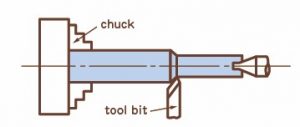
Image of chuck in use
When a cylindrical workpiece with short length is machined on a lathe, a holding tool called a chuck is often used. On the other hand, when a long and thin workpiece is machined on a lathe, the center of the tail stock which is not gripped by the chuck must be supported by a tool called “center”. This is to prevent the workpiece from flexing.
In the past, many general-purpose lathes were used at manufacturing sites, where the handles were moved manually by operators to control the movement of the tool bits. Currently, NC lathes equipped with NC devices are the most common type of lathe. NC stands for “Numerical Control”. NC lathes can control the movement of tool bits and other operations numerically. NC lathes can machine according to a programmed procedure, so it does not rely on operator’s intuition and skill, and maintains machining quality.
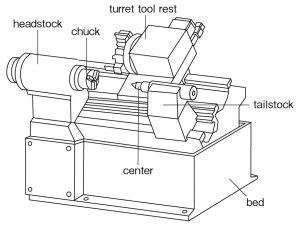
Diagram of basic configuration of lathes
A lathe is basically composed of a “headstock,” “tool rest,” “carriage,” “tailstock,” “bed,” “base,” and other parts. NC lathes are also equipped with NC devices and servo mechanisms to move the spindle and tool rest. The structure of the general-purpose lathe and NC lathe are largely the same, other than the NC device and servo mechanism.
The headstock incorporates the main spindle for mounting the workpiece. The main spindle is the key component of a lathe.
Tool rest is the device to attach various cutting tools including tool bit. The carriage is the stand on which the tool rests is placed.
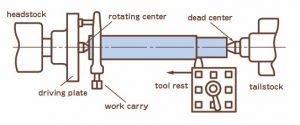
Image of the center in use
The tailstock is located opposite the spindle and has a built-in tailstock spindle. The tailstock spindle is equipped with a center.
The bed supports the head stock and carriage. The base is arranged at both ends of the lathe and supports the lathe body. There are many lathes in which the bed and base are integrated.
Lathes come in a variety of sizes. There are two indicators of lathe size: swing and distance between centers.
Swing refers to the maximum diameter of a workpiece that can be mounted on the lathe in terms of lathe structure.
Distance between centers represents the distance between the center of the spindle and the center of the tailstock when the tailstock is separated from the headstock to the maximum extent possible. In other words, it is the maximum length of a workpiece that can be mounted on the lathe.
Swing or distance between centers represents the maximum workpiece size that can theoretically be machined. However, if a workpiece of the maximum size is mounted on the lathe, the tool rest will not secure sufficient range of movement, and workability will be deteriorated. Therefore, the diameter and length of the workpiece to be mounted on the lathe should be kept so that it is not inconvenient for machining.
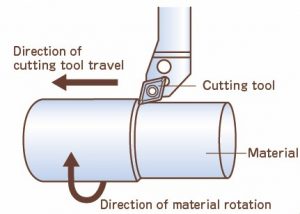
Basic image of the turning
There are various types of lathes: “gang tooling lathe,” “turret lathe,” “vertical lathe,” “automatic lathe,” and “turning center“.
Gang tooling lathes are equipped with a comb-blade-type turret, in which tool bits are arranged in parallel, like a hair comb. The turret moves on a plane parallel to the main spindle.
Turret lathes are equipped with the polygonal tool rest called turret. The tool bits are attached radially, and the turret rotates to index the bites to be used. Turret-type lathes are widely used among NC lathes.
Vertical lathes are the lathe whose spindle is oriented perpendicular to the ground. You may better understand it if you imagine a potter’s wheel for making ceramics.
The workpiece is set on a circular table mounted on the spindle for machining. Vertical lathes are used for machining workpieces that are difficult to mount in the chuck with a horizontal lathe whose spindle is horizontal to the ground. Target workpieces include large diameters and heavy workpieces, and workpieces with huge diameters relative to their length.
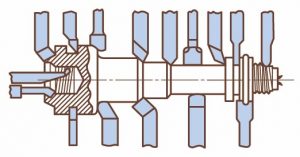
Various types of tool bit
Automatic lathes are suitable for mass production of same shape workpieces. Automatic lathes can be operated unmanned for long time when combined with a bar feeder that automatically feeds the bars of material. There are two types of automatic lathes: those with a movable spindle and those with a fixed spindle.
Spindle-moving types are suitable for mass-production machining of long and thin workpieces. It is also called “Swiss-style automatic lathes” because it was invented in Switzerland. On the other hand, in the case of fixed spindle type, the headstock does not move, and the tool rest moves in the direction of the spindle for workpiece machining. The fixed spindle type automatic lathe enables machining of thick and short workpieces.
Turning centers (TC) are the process-integration type machine tool with rotary tools mounted on the turret and gang of an NC lathe. Rotary tools are a general term for cutting tools, such as milling tools and end mills, that enables machining while rotating. In addition to turning, TC can also perform milling in a single machine.
Okuma develops vertical lathe suitable for titanium and inconel machining
March 24, 2025